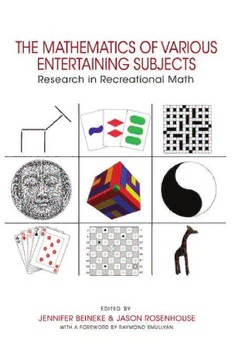
The Mathematics of Various Entertaining Subjects. Research in Recreational Math PDF
Preview The Mathematics of Various Entertaining Subjects. Research in Recreational Math
TheMathematicsofVariousEntertainingSubjects (cid:1)(cid:1)(cid:1)(cid:1)(cid:1)(cid:1)(cid:1)(cid:1)(cid:1)(cid:1)(cid:1)(cid:1)(cid:1)(cid:1)(cid:1)(cid:1)(cid:1)(cid:1)(cid:1)(cid:1)(cid:1)(cid:1)(cid:1)(cid:1)(cid:1)(cid:1)(cid:1)(cid:1)(cid:1)(cid:1)(cid:1)(cid:1)(cid:1)(cid:1)(cid:1)(cid:1)(cid:1)(cid:1)(cid:1)(cid:1)(cid:1)(cid:1)(cid:1)(cid:1)(cid:1)(cid:1)(cid:1)(cid:1)(cid:1)(cid:1)(cid:1)(cid:1)(cid:1)(cid:1)(cid:1)(cid:1)(cid:1)(cid:1)(cid:1)(cid:1)(cid:1)(cid:1)(cid:1) T M V HE ATHEMATICS OF ARIOUS E S NTERTAINING UBJECTS RESEARCH IN RECREATIONAL MATH (cid:1)(cid:1)(cid:1)(cid:1)(cid:1)(cid:1)(cid:1)(cid:1)(cid:1)(cid:1)(cid:1)(cid:1)(cid:1)(cid:1)(cid:1)(cid:1)(cid:1)(cid:1)(cid:1)(cid:1)(cid:1)(cid:1)(cid:1)(cid:1)(cid:1)(cid:1)(cid:1)(cid:1)(cid:1)(cid:1)(cid:1)(cid:1)(cid:1)(cid:1)(cid:1)(cid:1)(cid:1)(cid:1)(cid:1)(cid:1)(cid:1)(cid:1)(cid:1)(cid:1)(cid:1)(cid:1)(cid:1)(cid:1)(cid:1) EDITEDBY Jennifer Beineke & Jason Rosenhouse WITHAFOREWORDBYRAYMONDSMULLYAN NationalMuseumofMathematics,NewYork • PrincetonUniversityPress,Princeton&Oxford Copyright(cid:1)c 2016byPrincetonUniversityPress PublishedbyPrincetonUniversityPress,41WilliamStreet, Princeton,NewJersey08540 IntheUnitedKingdom:PrincetonUniversityPress,6OxfordStreet, Woodstock,OxfordshireOX201TW press.princeton.edu InassociationwiththeNationalMuseumofMathematics, 11East26thStreet,NewYork,NewYork10010 Jacketart:Clockwise:Row1,Fig.1:CourtesyofAnanyLevitin; Fig.2:Cardsandgame,c.1988,1991.Cannei,LLC. Allrightsreserved.SET(cid:1)andallassociatedlogosandtaglinesare registeredtrademarksofCannei,LLC.Usedwithpermissionfrom SETEnterprises,Inc.;Fig.3:CourtesyofJohnK.McSweeney. Row2,Fig.4:CourtesyofRobertBosch;Fig.5:CourtesyofBurrTools/ AndreasRöver;Fig.6:CourtesyofAnanyLevitin. Row3,Fig.7:CourtesyofO.Encke,www.encke.net;Fig.8:Courtesyof AnanyLevitin;Fig.9:CourtesyofJenniferBeinekeandLowellBeineke. AllRightsReserved ISBN978-0-691-16403-8 LibraryofCongressControlNumber:2015945218 BritishLibraryCataloging-in-PublicationDataisavailable ThisbookhasbeencomposedinMinionPro Printedonacid-freepaper.∞ TypesetbySRNovaPvtLtd,Bangalore,India PrintedintheUnitedStatesofAmerica 13579108642 Contents (cid:1)(cid:1)(cid:1)(cid:1)(cid:1)(cid:1)(cid:1)(cid:1)(cid:1)(cid:1)(cid:1)(cid:1)(cid:1)(cid:1)(cid:1)(cid:1)(cid:1)(cid:1)(cid:1)(cid:1)(cid:1)(cid:1)(cid:1)(cid:1)(cid:1)(cid:1)(cid:1)(cid:1)(cid:1)(cid:1)(cid:1)(cid:1) (cid:1)(cid:1)(cid:1)(cid:1)(cid:1)(cid:1)(cid:1)(cid:1)(cid:1)(cid:1)(cid:1)(cid:1)(cid:1)(cid:1)(cid:1)(cid:1)(cid:1)(cid:1)(cid:1)(cid:1)(cid:1)(cid:1)(cid:1)(cid:1)(cid:1)(cid:1)(cid:1)(cid:1)(cid:1)(cid:1)(cid:1)(cid:1) ForewordbyRaymondSmullyan vii PrefaceandAcknowledgments x PARTIVIGNETTES 1 ShouldYouBeHappy? 3 PeterWinkler 2 One-MovePuzzleswithMathematicalContent 11 AnanyLevitin 3 MinimalistApproachestoFigurativeMazeDesign 29 RobertBosch,TimChartier,andMichaelRowan 4 SomeABCsofGraphsandGames 43 JenniferBeinekeandLowellBeineke PARTIIPROBLEMSINSPIREDBYCLASSICPUZZLES 5 SolvingtheTowerofHanoiwithRandomMoves 65 MaxA.AlekseyevandTobyBerger 6 GroupsAssociatedtoTetraflexagons 81 JulieBeierandCarolynYackel 7 ParallelWeighingsofCoins 95 TanyaKhovanova 8 AnalysisofCrosswordPuzzleDifficultyUsinga RandomGraphProcess 105 JohnK.McSweeney 9 FromtheOutsideIn:SolvingGeneralizationsofthe Slothouber-Graatsma-ConwayPuzzle 127 DerekSmith PARTIIIPLAYINGCARDS 10 GalliaEstOmnisDivisainPartesQuattuor 139 NeilCalkinandColmMulcahy vi • Contents 11 HeartlessPoker 149 DominicLanphierandLauraTaalman 12 AnIntroductiontoGilbreathNumbers 163 RobertW.Vallin PARTIVGAMES 13 Tic-tac-toeonAffinePlanes 175 MaureenT.CarrollandStevenT.Dougherty 14 (cid:1) ErrorDetectionandCorrectionUsingSET 199 GaryGordonandElizabethMcMahon 15 ConnectionGamesandSperner’sLemma 213 DavidMolnar PARTVFIBONACCINUMBERS 16 TheCookieMonsterProblem 231 LeighMarieBraswellandTanyaKhovanova 17 RepresentingNumbersUsingFibonacciVariants 245 StephenK.Lucas AbouttheEditors 261 AbouttheContributors 263 Index 269 Foreword (cid:1)(cid:1)(cid:1)(cid:1)(cid:1)(cid:1)(cid:1)(cid:1)(cid:1)(cid:1)(cid:1)(cid:1)(cid:1)(cid:1)(cid:1)(cid:1)(cid:1)(cid:1)(cid:1)(cid:1)(cid:1)(cid:1)(cid:1)(cid:1)(cid:1)(cid:1)(cid:1)(cid:1)(cid:1)(cid:1)(cid:1) (cid:1)(cid:1)(cid:1)(cid:1)(cid:1)(cid:1)(cid:1)(cid:1)(cid:1)(cid:1)(cid:1)(cid:1)(cid:1)(cid:1)(cid:1)(cid:1)(cid:1)(cid:1)(cid:1)(cid:1)(cid:1)(cid:1)(cid:1)(cid:1)(cid:1)(cid:1)(cid:1)(cid:1)(cid:1)(cid:1)(cid:1) RaymondSmullyan Recreational mathematics can provide a most pleasant introduction to deep resultsinmathematicsandlogictothegeneralpublic.Forexample,takethe field known as propositional logic, which deals with the way simple proposi- tionsarecombinedtoformmorecomplexpropositions,usingtheconnectives not,and,or(where“or”shouldbetakeninthesenseof“atleastone,”)if-then, and if and only if. I have found that a most useful way of approaching this subjectisbythelogicoflyingandtruth-telling,whichpeoplecanrelatetoquite easily.AndsoletusturntoaplaceIhavedubbedtheIslandofKnightsand Knaves,inwhichknightsalwaystellthetruthandknavesalwayslie,andeach nativeoftheislandiseitheraknightoraknave.Supposeyouvisittheisland andcomeacrosstwonatives,AlanandBob,andAlansays,abouthimselfand Bob,“Bothofusareknaves.”IsAlanaknightoraknave,andwhatisBob? This problem is pretty easy: No knight could falsely claim that he and someone else were both knaves, hence Alan is obviously a knave. Since his statement is false, it is not true that both are knaves, and so at least one is a knight,andsinceitisnotAlan,itmustbeBob. Foraslightlyharderproblem,supposethatinsteadofsaying,“Bothofus areknaves,”Alanhadsaid,“Atleastoneofusisaknave,”(or,whatamounts tothesamething,hecouldhavesaid,“EitherI’maknaveorBobisaknave.) Now,whatareAlanandBob?Wouldyoucaretotrysolvingthisbeforereading further? Hereistheanswer:IfAlanwereaknave,thenitwouldbetruethatatleast oneofthemwasaknave,butknavesdon’tmaketruestatements.HenceAlan cannotbeaknave;hemustbeaknight.ItfurtherfollowsthatasAlantruthfully saidatleastoneisaknave,butsinceitisnotAlan,itmustbeBob.Hencethe answeristheoppositetothatofthefirstproblem—nowAlanisaknightand Bobisaknave. Theabovetwoproblemswererespectivelyconcernedwithandandor.Now foroneconcernedwithif-then. SupposeAlansaid,“IfIamaknight,thensoisBob.”CanthetypesofAlan andBobnowbeestablished?Trythisone! Yes,bothtypescanbeestablished,andtheargumentisdelightfullysubtle! Suppose Alan is a knight. Then, as he truthfully says, if Alan is a knight, so is Bob, and since Alan is a knight (by supposition), Bob is also a knight. viii • Foreword Thisproves,notthatAlanisaknight,northatBobisaknight,butonlythat if Alanisaknight,soisBob.ThuswenowknowthatifAlanisaknight,so isBob,butsinceAlansaidjustthat,hespoketruthfully,henceheisaknight. Furtheritisalsotruethatifheisaknight,soisBob(ashetruthfullysaid),and sinceheisaknight,soisBob.Thus,theansweristhattheyarebothknights. Finally, consider the case in which Alan says: “Bob and I are of the same type—both knights or both knaves.” Can Alan’s type be determined? What aboutBob’s? WewillseethattheansweristhatAlan’stypecannotbedetermined,but Bob’stypecanbe.Tobeginwith,letusnotethatnonativeofthisislandcan claimtobeaknave,becausenoknightwouldfalselydoso,andnoknavewould truthfullydoso.Therefore,ifBobwereaknave,thenAlancouldneverhave claimedtobethesametypeasBob,asthiswouldbetantamounttoclaimingto beaknave!ThusBobmustbeaknight.AstoAlan,hecouldbeaknight,who truthfullyclaimedtobelikeBob,oraknave,whofalselyclaimstobelikeBob, andthereisnowayoftellingwhich. Next,Iwishtoconsiderarecreationalproblemthatisrelatedtoafunda- mentaldiscoveryinmathematicallogic,whichIwilllatertellyouabout. A certain logician, whom we will call Larry, is completely accurate in his proofs—everythinghecanproveisreallytrue.HevisitstheIslandofKnights andKnavesandcomesacrossanativenamedJal,whosaystohim,“Youcan neverprovethatI’maknight.”IsJalaknightoraknave?Yes,thiscanreally bedetermined!Wanttotry? Here is the answer, which may be a bit startling: Jal must be a knight, but Larry can never prove that he is! Here is why: If Jal was a knave, then contrarytowhathefalselysaid,Larrycould provethatJalisaknight,which goescontrarytothegivenconditionthatLarryneverprovesfalsepropositions. Hence,Jalcannotbeaknave;hemustbeaknight.Hence,ashetruthfullysaid, LarrycanneverprovethatJalisaknight.ThusJalisreallyaknight,butLarry canneverprovethatheis. This problem was suggested to me by the discovery of the great logician Kurt Gödel, that for the most powerful mathematical systems yet known, there must always be sentences which, though true, cannot be proved in the system.Foreachofthesesystems,aswellasvarietiesofrelatedsystems,Gödel showed how to construct a sentence—call it “G”—which asserted its own nonprovability in the system. That is, G is either true but not provable in the system, or G is false but provable in the system. The latter alternative is ruledoutbythereasonableassumptionthatthemathematicalsystemsunder considerationarecorrect,inthesensethatonlytruesentencesareprovablein them.Thusthefirstalternativeholds:G istruebutnotprovableinthesystem. HowdidGödelconstructasentencethatasserteditsownnonprovability? Thefollowingproblemshouldillustratetheessentialidea. Consider a computing machine that prints out expressions composed of thefollowingfivesymbols:(,),P,N,andD.Anexpressioniscalledprintable Foreword • ix if the machine can print it. We will call an expression X regular if it is compounded from just the three symbols, P,N, and D (thus it has no parentheses). For any regular expression X, by the diagonalization of X is meant the expression X(X)—for example, the diagonalization of PNPD is PNPD(PNPD).Byasentenceismeantanyexpressionofoneofthefollowing forms,where Xstandsforanyregularexpressionwhatever: 1. P(X) 2. NP(X) 3. PD(X) 4. NPD(X) Thesesentencesareinterpretedasfollows(thesymbols P, N, D,respectively, standforprintable,not,anddiagonalizationof): 1. P(X)meansXisprintable,andisaccordinglycalledtrueif(andonly if) Xisprintable. 2. NP(X)iscalledtrueifandonlyif Xisnotprintable. 3. PD(X) is called true if and only if the diagonalization of X is printable.(Itisread,“PrintablethediagonalizationofX,”or,inbetter English,“Thediagonalizationof Xisprintable.”) 4. NPD(X) is called True if and only if the diagonalization of X not printable. We are given that the machine is totally accurate in the sense that all printablesentencesaretrue.Forexample,if P(X)isprintable,then X isalso printable, as P(X) truthfully says. But suppose that X is printable. Does it follow that P(X) is printable? Not necessarily! If X is printable, then P(X) is true, but we are not given that all true sentences are printable; only that printablesentencesaretrue.Asamatteroffact,thereisatruesentencethatis notprintable,andtheproblemistoexhibitone.Caretotry? Well,hereisone:weknowthatforanyregularexpression X,thesentence NPD(X) is true if and only if the diagonalizationof X is notprintable. We taketheexpressionNPDforX,andsoNPD(NPD)istrueifandonlyifthe diagonalizationof NPD isnotprintable,butthediagonalizationof NPD is theverysentence NPD(NPD)!Thus NPD(NPD)istrueifandonlyifitis notprintable,whichmeansitiseithertrueandnotprintable,orelsenottrue but printable. The latter alternative is ruled out by the given condition that onlytruesentencesareprintable,henceitmustbetruethat NPD(NPD)is true,butthemachinecannotprintit. Thissentence NPD(NPD)obviouslycorrespondstoGödel’ssentenceG, whichassertsitsownnonprovability. Thisisjustoneexamplewhererecreationalmathematicsleadsyounaturally into the deepest topics in mathematics. In this volume, you will enjoy many othermathematicaltopicsintroducedbyrecreationalpuzzles!
